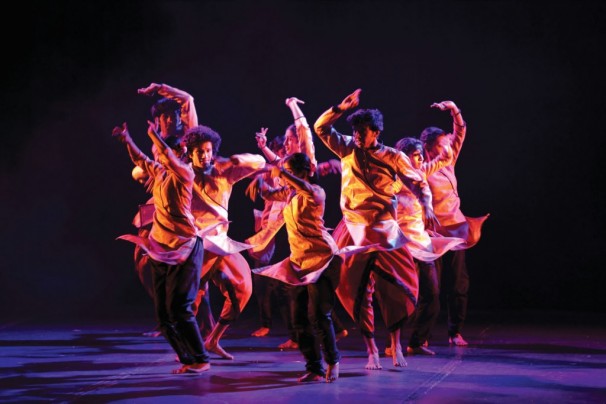INDIAN TAKE ON SPANISH LIT SOLD OUT AT UD
Photo: The Sahrdaya Foundation will present a sold-out performance of Don Quixote on Sept. 24 at the University of Dayton
 Since 1961 when the University of Dayton’s ArtsLIVE was founded as the Arts Series, it has evolved from simply presenting music concerts to filling a more complex niche in Dayton’s well-populated landscape of professional arts and culture. While presenting performances is its business, there is the business of the university’s commitment to developing students who appreciate diverse cultures through critical understanding—a much loftier charge than putting bodies in seats. Ticket sales count, but so do quality, point of view, diversity and a production’s ability to dovetail academics.
Since 1961 when the University of Dayton’s ArtsLIVE was founded as the Arts Series, it has evolved from simply presenting music concerts to filling a more complex niche in Dayton’s well-populated landscape of professional arts and culture. While presenting performances is its business, there is the business of the university’s commitment to developing students who appreciate diverse cultures through critical understanding—a much loftier charge than putting bodies in seats. Ticket sales count, but so do quality, point of view, diversity and a production’s ability to dovetail academics.
With such a high list of qualifiers, ArtsLIVE coordinator Eileen Carr and the ArtsLIVE advisory committee exercise discernment when deciding what fits their bill. What are the high-quality, diverse performances that promote critical thinking and are as at home in the classroom as on stage? Rarities, by meaning, do not happen regularly. What may work is a scholar’s creative stage adaptation of a 400-year-old, highly acclaimed, widely taught, Spanish, literary work of fiction grounded with Indian classical dance and music. As it turns out, such a thing exists. “The Ingenious Gentleman Don Quixote de La Mancha,” by Miguel de Cervantes Saavedra, was published in two separate volumes in 1605 and 1615—400 years ago this year. For the past two years, a world away from Dayton, in Chennai, India, a group of classically trained artists envisioned the text brought to life by their collective expertise. The publication’s anniversary could not have come at a better time.
The result, Sahrdaya Foundation’s Don Quixote, will open the ArtsLIVE season on Thursday, Sept. 24 at 8 p.m, at the Kennedy Union’s Boll Theatre on UD’s campus. The multi-layered production was in the making for over a year and a half according to Sheejith Krishna, director and founder of Sahrdaya Foundation and choreographer of Don Quixote. It premiered in Chennai at the Music Academy on March 28, 2015. The evening-length dance-music-theatre production is told in 16 scenes and features 13 dancers and actors. Its multi-city tour of the United States began in August.
Even though this version of Don Quixote may seem out of the ordinary compared to prevailing western ballets after the novel, it reflects the foundation’s core artists and their experiences with classical dance, music and literature. The European classical arts are not the only classical forms in the world.
Classical Bharata Natyam dates back 2,000 years to its beginnings as a temple dance tradition in southern India. Today, it can be as contemporized into different movement languages as any classical base. However, when used conventionally its linear placement of the limbs and stable torso read angular or geometric from the stage. Dancers cover the floor in linear spatial arrangements. Its strong lines are rounded out by pronounced gesture and footwork that keeps close to its musical accompaniment. Bharatanatyam is dynamic and appears to be a story on the body with or without a script to support it.
Likewise, Carnatic music, the domain of another founding member of Sahrdaya, Jyothishmathi Sheejith, is an Indian classical form with a documented history dating back to the 13th century although some theorists claim its origins as far back as the 5th century. Akhila Ramnarayan’s script, using a 400-year-old novel as inspiration, makes it clear that classicism’s domain is as imaginatively vibrant in southern India as anywhere in the world. Along with Sheejith Krishna, the foundation’s core artists, Bharatanatyam dancers Manjari and Anjana Anand, literary scholar, Akhila Ramnarayan, and Carnatic musician, Jyothishmathi Sheejith, synergistically realized Don Quixote.
A Bharatanatyam student and teacher for over 21 years, Sheejith Krishna sees classical study as language acquisition to be used to express creative ideas. In addition to Bharatanatyam, he trained in two Carnatic forms: a vocal percussion called konnakol and mridangam, a Carnatic drum.
“If you learn a classical art form, the classicism and rigorous discipline allow you to integrate your body and mind to explore a wider sphere of thought,” he says.
In arts ventures a successful exploration of new ideas includes audience, but artists begin by making stage worthy work that reflects their intent. Collaborator Akhila Ramnarayan has a scholar’s intimacy of the source text; she served as assistant professor of post-colonial studies in UD’s English department from 2005-2011. The iterations of her original script were influenced by watching choreography and listening to music being built and refashioned concurrently. “Often, the choreography would inspire and shape my vision for a poem or a song,” she says. “It was mystifying sometimes … sometimes I wonder how we even got here. But that’s what’s beautiful about collaboration.”
One of the benefits of artists’ collaborative organizations is the ongoing contact that fosters play: reposition the order of the familiar to form a language previously unspoken. Maybe music is more than staid prescription of singing and playing instruments. It can be altered by character or partnered with narrative or movement to complete a different story than it would tell on its own. Jyothishmathi Sheejith, the composer of Don Quixote’s score, used a Carnatic base that took on string and percussion instruments from the east and west according to Sheejith Krishna. The resulting soundtrack is a diverse mix of musical traditions executed by over 60 musicians and professionally engineered and programmed for performances.
The longevity and repetitive practice of classical art forms present opportunities to stay fixed in technique, story line, counts and comparisons to older versions; however, that puts relevance at stake. Today, worldviews are blended by our increased movement. We extend our traditions to different continents where we travel or have digital access to people with uncommon interpretations. UD’s ArtsLIVE presentation of Don Quixote speaks to the modernity of a rapidly evolving confluence of languages and meanings all over the world.
The UD performance is already sold out—the first time in ArtsLIVE history a performance has sold out a week prior to the show date. However, a free simulcast of he performance will be on view in the KU East Ballroom for walk-up patrons.
ArtsLive presents the Sahrdaya Foundation’s Don Quixote on Thursday, Sept. 24 at 8 p.m. in the Kennedy Union Boll Theatre on UD’s campus. For tickets and more information, please visit udayton.edu. The gallery at Roesch Library has an exhibit of 25 objects from its collection of Don Quixote texts. On Display: Editions of Don Quixote is open to the public through Sept. 27. Visit udayton.edu/libraries for additional information.
Reach DCP freelance writer Arnecia Patterson at ArneciaPatterson@DaytonCityPaper.com
– See more at: http://www.daytoncitypaper.com/don-quixotes-chivalrous-pairing/

